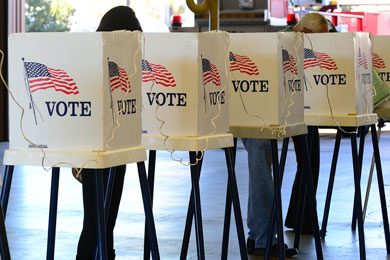Elaine Schmottlach has been a ballot clerk in the small southeastern New Hampshire town of Nottingham – population, 4,785 – for the last 25 years. Yet when it came time for her to vote on Nov. 6, she had to show valid photo identification as required under a new state law.
Schmottlach refused and submitted a challenged voter affidavit instead.
“My view is this is a horrendous law,” she told ProPublica. “I absolutely detest it. I hated having to ask my best friend to show an ID to prove that she is who she is.”
Schmottlach’s act of defiance didn’t have much effect – this time. Her vote still counted, she wasn’t handed a provisional ballot and she wasn’t required to return to the poll with ID. But that could change in future elections under New Hampshire’s plans to phase in the new law.
In the months leading up to the election, voter ID laws were seen as the biggest threat to voter turnout: More than 30 states have passed such laws, which require voters to provide some type of identification at the polls (see our previous explainer).
But many of these laws, particularly the ones requiring strict photo identification, met setbacks ahead of the election. A state judge ruled in October that Pennsylvania’s law couldn’t be implemented this election, while federal judges refused to allow similar measures take effect this year in Texas and South Carolina.
A week before the election, the Brennan Center for Justice concluded that “for the overwhelming majority of those whose rights were most at risk, the ability to vote will not be at issue on November 6th.”
Experts agree that much-assailed voter ID laws were less an issue in this election than limited early voting hours, lengthy ballots and precincts shuttered after Hurricane Sandy. These issues contributed to long wait times, prompting some to simply throw up their hands and give up on voting.
“Of all the issues relating to voting rules, voter ID got the most attention but was probably the least significant, mainly because we didn’t have it in Pennsylvania,” said Rick Hasen, a professor at the University of California-Irvine who specializes in election law.
In Pennsylvania, where some feared the state’s continuing efforts to advertise the new law would confuse voters, election officials were required to ask voters for ID , but were not allowed to prevent anyone from casting a ballot for failure to produce one.
“On November 6, it was a dry run just as it was in the (April 24) primary,” said Ellen Kaplan, vice president and policy director at the Committee of Seventy, a non-partisan voter education group in Philadelphia. “We don’t know how many people might have been confused and didn’t show up. Among the people that did show up, there was certainly some confusion out there. But I wouldn’t characterize it as so overwhelming that it disrupted the voting process.”
In December, a state judge is expected to hear arguments to permanently block the controversial law.
In Virginia, which instituted a voter ID law approved by the Justice Department in August, watchdog groups reported few disruptions. (The state has a less stringent law, accepting non-photo IDs such as recent utility bills, bank statements or paystubs.)
The Virginia State Board of Elections estimated that there were 543 provisional ballots cast as a result of voters lacking valid ID – representing less than 5 percent of the total number of provisional ballots cast statewide.
In Tennessee, where a new photo voter ID law went into effect this year, the Secretary of State’s Office reported no negative impact on turnout, reporting turnout rates “consistent with past presidential elections,” said Communications Director Blake Fontenay.
“If anything, the law may have encouraged more people to vote because they were more confident their ballots would not be cancelled out by ballots cast by ineligible voters,” Fontenay told ProPublica.
Out of 2.45 million ballots cast statewide, 674 Tennessee voters filled out provisional ballots for lacking acceptable photo ID.
New Hampshire Deputy Secretary of State Dave Scanlan said that while the state doesn’t have a final tally on voters who filled out challenged voter affidavit forms as a result of lacking ID, the number “appears to be quite low – possibly less than 1 percent.”
Elsewhere, there have been reports that momentum against voter-ID laws, seen by critics to disproportionately affect minority, elderly and poor voters, actually helped turnout, but the evidence is spotty.
According to a preliminary analysis by the Committee of Seventy, voter turnout in Philadelphia decreased from 61.6 percent in 2008 to 59.7 percent this year. The group’s data also shows that Barack Obama won the city by a comparable margin this year, 467,000 votes, as he did four years ago, when his edge was 461,670 votes.
As Nate Silver’s FiveThirtyEight’s blog notes, voter turnout across the county, particularly in states pushing for new voter-ID laws, was all over the map, according to the early estimates. Virginia saw a slight increase, New Hampshire stayed virtually the same, while Pennsylvania cast fewer votes than in 2008.
All this doesn’t mean that voting was problem-free. According to The Lawyers’ Committee for Civil Rights Under Law, a national election law hotline fielded roughly 90,000 concerned calls this Election Day, down from 100,000 in 2008. Many of the calls related to antiquated voting machines, names not appearing on voter registration rolls, and polling place confusion.
“What we saw, by and large, was the same problems we’ve seen over the last 10 years,” said Eric Marshall, manager of legal mobilization for the Lawyers’ Committee. “The biggest theme was the recurring problems: the more things change, the more things stay the same.”











